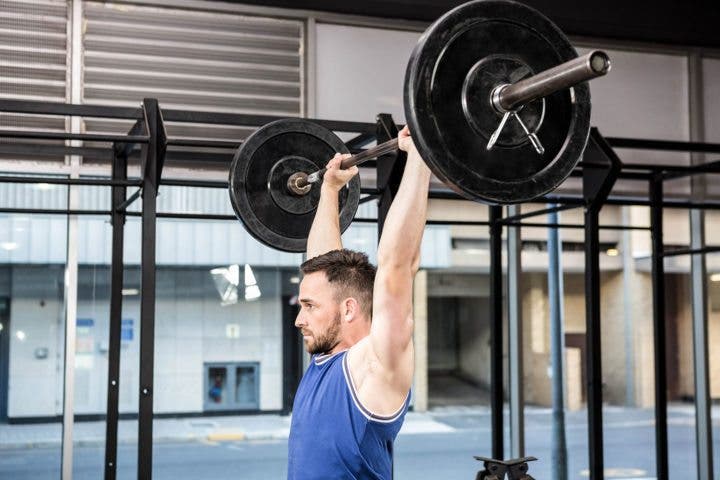Free weight training is one of the most popular means of improving strength and building muscle. However, on certain occasions and depending on the individual qualities of each person, this type of training can be complex and cause certain errors that are very common.
Before or after, training with free weights should be one of the training priorities once you have the appropriate physical qualities, since in daily actions we handle free weights at all times. Before doing so, you should know the 10 most common mistakes to avoid during your weight training .

10 common weight training mistakes
1. Training without training planning
It is really shocking to observe the vast majority of people who train in a gym without any material in which they have their training planned with the specific exercises and the appropriate training dose (volume, intensity, density, selection of exercises).
Organizing your workouts is the key to progress and achieve your goals. On the contrary, improvising in each workout without performing each action for no specific reason will lead to the most absolute failure.
2. Not controlling the rest time
Controlling the rest time between sets is absolutely necessary if you are looking for one goal or another. For example, if you are looking to maximize strength, you will likely need 2-3 minute breaks, and even longer. If you do not control this aspect rigorously, you can be sure that the adaptations in your body will be different.

3. Not having a specific goal
It doesn’t matter what kind of goal you have, as long as it’s realistic, but you need to set one for yourself. The emotional component of training makes it necessary to set goals in order to know in which direction your training is going and that it is efficient and effective. In addition, he thinks that having motivations to continue training is important, everything in life must be done with a motivation or purpose, and it is no less in weight training.
4. Train in the same way as others
Training like other people is not going to help you progress. Think that your individual characteristics are unique and that therefore you will always need something different than the others. This is not to say that you cannot perform certain similar exercises, but keep in mind that not all of your training may be exactly similar to someone else’s .

5. Having too much ego
To progress it is necessary to put aside your ego and not think that lifting more weight is better, since it is most likely that with less you will achieve the same or even better results. In addition, by moving a lower weight you will likely be able to control the movement technique much better, be effective in the exercise and avoid a high risk of injury.
Be honest with yourself and try to control your training safety above all else. Once you master this, you can progress without forgetting to do so with humility.
6. Having training sessions that are too long
On many occasions we think that more time and more frequency of training will be better, and this is not really true. It is believed that if 1 hour of exercise is good, 2 hours is better and therefore better results. Like the more days a week of training the better results.
Probably if you train in an organized and controlled way for 1 hour, 3-4 days a week will be more than enough to be able to progress in your weight training.

7. Always do the same training
One of the most common mistakes made by those who go to the gym is running the same workout for years . Obviously that way they will not be able to progress.
Our body is really fabulous and is able to adapt quickly to the stimuli that are provoked. In other words, in order to progress, it is necessary for the body to receive different stimuli to prevent it from “getting used to” the same training. For this you must vary the amount of training, exercises, training days, etc.
8. Train to muscle failure
Many people believe that training to muscle failure – the point where you can’t keep doing more reps with the same external load – is really good for building muscle strength.
Admittedly training to failure are achieved activate certain bundles or muscle fibers but recently, a recent meta-analysis has been postulated as follows: “Despite the levels of discomfort and effort physical after training to failure, training without reaching the failure generates the same strength gains without causing a high risk of injury and overtraining ”(1).

9. Have a helper to lift “more weight”
When training with a high load it is recommended that someone watch and be willing to help, if they really know how to do it, in case the technique gets out of control or no more repetitions can be performed. However, it is very different if someone helps you mobilize the weight to continue doing more repetitions.
Having a spotter just to do more reps doesn’t make much sense since you won’t be moving the same weight, you will actually be moving a lot less since someone else is doing it for you.
10. Do not perform multi-joint movements
Performing analytical and single-joint exercises can be effective depending on your needs, but generally prioritizing global and multi-joint movement will benefit you the most.
This fact is due to the fact that you will involve greater muscle mass, you will mobilize your body in a natural way and you will achieve a greater increase in your strength. Exercises like squats, deadlifts and Olympic movements will help you improve your strength more effectively than through more analytical exercises.

Reference
- Davies, T. Orr, R. Halaki, M. and Hackett, D. (2016). Effect of training leading to repetition failure in muscle strength: A systematic review and Meta-analysis. Journal of Sports Medicine, 46 (4): 487-502.